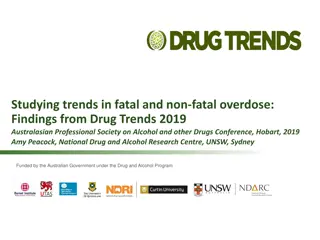E-Learning Benefits and Trends
E-learning, also known as online learning, is a rapidly growing educational approach that offers convenience and flexibility to learners. This mode of learning allows students to access course materials, interact with instructors, and engage with peers virtually. With the rise of e-learning programs, individuals and organizations benefit from improved learning outcomes, cost-effectiveness, and customizable learning experiences. Explore the important facts, statistics, and reasons why e-learning is becoming increasingly popular worldwide.
Download Presentation

Please find below an Image/Link to download the presentation.
The content on the website is provided AS IS for your information and personal use only. It may not be sold, licensed, or shared on other websites without obtaining consent from the author.If you encounter any issues during the download, it is possible that the publisher has removed the file from their server.
You are allowed to download the files provided on this website for personal or commercial use, subject to the condition that they are used lawfully. All files are the property of their respective owners.
The content on the website is provided AS IS for your information and personal use only. It may not be sold, licensed, or shared on other websites without obtaining consent from the author.
E N D
Presentation Transcript
Pharmacotherapy for obesity and type 2 diabetes By:dr narimani
REFERENCES Guidelines for Obesity Management Pharmacotherapy for Obesity Type 2 Diabetes Treatment in the Patient with Obesity Endocrinol Metab Clin N Am 45 (2016)
INTRODUCTION An estimated 347 million adults live with type 2 diabetes (T2D) worldwide, about half of whom are undiagnosed. Although the cause for T2D is multifactorial, nearly 80% of all people with T2D are obese. This strongly suggests that obesity may play a central role in the progression from normal glucose tolerance to frank T2D.
The mechanism by which obesity promotes T2D is an area of intense research but inadequate compensation of the b cells in response to an increasingly insulin-resistant skeletal muscle and liver characterize T2D. It is now recognized that individuals with impaired glucose tolerance (prediabetes) have lost upward of 80% of their b-cell function and have comparable degrees of insulin resistance to clinical T2D
In addition, adipose tissue is considered a chief culprit in the development of multiorgan insulin resistance and b-cell dysfunction through increased circulatory factors (free fatty acids, leptin, and so forth) that promote hyperglycemia.
Newer understandings of T2D pathophysiology acknowledge that the gastrointestinal tract (eg, small intestine), kidney, and brain in addition to the a forementioned organs collectively play an important role in the progression to T2D.
Thus, identification of end-organ targets that promote hyperglycemia is critical to the advancement of successful treatment strategies. As a result, efforts are needed to make clinical decisions based on the underlying pathophysiologic abnormality.
Recently obesity has been considered a disease by major health organizations, although others consider obesity to be simply a side effect of energy imbalance. Focus be placed on intensifying efforts to improve weight management and glycemic control to combat the increased incidence of cardiovascular disease (CVD) in people with T2D.
Here, we discuss studies relevant to addressing antiobesity therapeutic options for the individual with T2D and dual actions to improve glycemic control. We present evidence suggesting that lifestyle modification directly and successfully induces meaningful weight loss by inducing a negative energy balance.
Also highlighted are recent advances in the understanding of pharmacologic interventions that drive weight loss and improve insulin sensitivity and b-cell function with or without lifestyle modification. Lastly, we discuss the inclusion of bariatric surgery into the algorithm for diabetes therapy, and close with a discussion of the clinical importance of combining exercise and diet with pharmacology or bariatric surgery as needed disease modification.
Evaluation of the patient body mass index (BMI) the distribution of fat based upon the waist circumference and investigations for comorbid conditions such as: Diabetes mellitus Dyslipidemia Hypertension heart disease, sleep apnea, and symptomatic osteoarthritis.
DIAGNOSIS OF OBESITY AND STAGING OF DISEASE If patients meet criteria of overweight (BMI 25- <30 kg/m2) and there are risk factors or comorbidities present, then all relevant guidelines ,endorse medically directed weight loss intervention as a path to improve health risk. obesity (BMI 30 kg/m2) mandates medical counseling for weight loss, with one exception. A discrepancy arises in guidance for individuals who have BMI of 30 kg/m2 or higher but have no risk factors. This is sometimes referred to as metabolically healthy obese and by AACE4 as obesity stage 0.
According to the 2013 American Heart Association, American College of Cardiology, and The Obesity Society Guideline for the Management of Overweight and Obesity in Adults, pharmacotherapy for the treatment of obesity can be considered if a patient has: A body mass index (BMI) 30 kg/m2 A BMI 27 kg/m2 with weight-related comorbidities, such as hypertension, type 2 diabetes, dyslipidemia, and obstructive sleep apnea
Anti obesity drugs alone? Along with diet, exercise, and behavior modification, drug therapy may be a helpful component of treatment for patients who are overweight or obese.
MANAGEMENT OF TYPE 2 DIABETES FOLLOWING LIFESTYLE MODIFICATION A central goal of diabetes care is to aid individuals in making better lifestyle decisions that lead to healthier body weights because obesity is the basic risk factor for T2D. Indeed, sedentary behavior and increased caloric intake are two key factors known to trigger insulin resistance and force the b- cell to secrete more insulin
In contrast, lifestyle intervention consisting of increased physical activity and low-fat diet reducing weight by approximately 5 kg for 2 years or beyond lowers diabetes risk by 30% to 60%. Weight loss of 2% to 5% over 1 to 4 years decreases hemoglobin (Hb) A1c by 0.2% to 0.3%. losses of 5% to 10% at 1 year are associated with reductions in HbA1c of 0.6% to 1.0%.
The Finnish Diabetes Prevention Study provided advice for subjects to lose greater than 5% weight loss by: 1) decreasing total fat less than 30% of total calorie intake (with <10% coming from saturated fat) 2) increasing fiber consumption (ie, 15 g per 1000 kcal), 3) increasing physical activity (30 min/d)
This lifestyle prescription lowered the cumulative incidence of diabetes by 58% in people with prediabetes compared with control subjects. The US Diabetes Prevention Program (DPP) Study, which recommended people with prediabetes exercise 150 min/wk and loss of 7% of weight showed that new diabetes cases were lowered by 58% Subjects who lost the most weight and met physical activity/diet targets had greater than 90% risk reductions of diabetes
These reports are consistent with recent work showing that the combination of a wellbalanced diet (eg, low-fat and high- fiber diet) promoting approximately 5% to 8% weight loss with increased physical activity is a well-established strategy for managing T2D because higher doses of physical activity generally increase insulin sensitivity and b-cell function
Although caloric restriction is arguably the most important factor driving weight loss, it remains possible that low carbohydrate intake per se may yield greater reductions in circulating blood glucose and body weight, particularly during the first few months of a lifestyle program. Nevertheless, increased physical activity is a primary determinant of maintaining the lost weight.
As such, structured exercise interventions in particular have been shown to significantly improve HbA1c levels, although some work suggests that not all people with hyperglycemia respond favorably to standard lifestyle interventions
weight loss may be the most important contributor to T2D prevention. Further work is required to understand why some people with hyperglycemia do not respond to traditional lifestyle modification? to determine the optimal exercise prescription for diabetes prevention and treatment?
The role of drug therapy ?? has been questioned, because of concerns about: efficacy body weight slows and then plateaus with continued treatment most patients regain weight when their weight-loss drugs are stopped. safety
GOALS OF THERAPY The ideal outcome is a return to normal body weight, but this is usually unrealistic?! Success may be measured by the degree of weight loss and improvement in associated risk factors Weight loss should exceed 2 kg during the first month of drug therapy (one pound per week) fall > 5% below baseline between 3 to 6 months, and remain at this level to be considered effective at least 5% statistically significant placebo-ad justed weight loss at 1 year or 35% or more of patients must achieve at least 5% weight loss (which must be at least twice that induced by placebo).
GOALS OF THERAPY . Improvement in baseline risk factors after weight loss is an important criterion in the determination of whether to continue therapy
Definitions (In drug trials ): Good response or effective: > 5% very good response: weight loss of 10 to 15 % using both drug and behavioral intervention excellent response: weight loss exceeding 15 percent However, a drug may produce side effects that can reduce its overall benefits.
Some facts: Drug therapy does not cure obesity. Patients with obesity given drugs should be advised that when the maximal therapeutic effect is achieved, weight loss ceases. When drug therapy is discontinued, weight is expected to rise.
Pharmacologic options: Orlistat lorcaserin Phentermine-extended release topiramate (in one capsule) Bupropion-naltrexone (in one extended-release tablet) Liraglutide (daily injection) phentermine
Antiobesity drugs individualization If weight loss is unsatisfactory (< 5 % below baseline at 3 to 6 months), then pharmacologic therapy can be discussed with the patient. the decision to use pharmacologic therapy should be individualized, The choice of antiobesity drugs is often governed by: Comorbidities relative contraindications
Drug selection for other diseases When overweight patients have DM, depression, behavioral problems, or CVD, select drugs which produce weight loss, rather than weight gain, when benefits in total outweigh risks of adverse effects. Several drugs are well known to produce weight gain and should be avoided if good alternatives are available weight loss must be balanced against other factors (ability to achieve desired glycemic control, other side effects and expense).
Weight centric approach A drug that results in better glycemia at the expense of a few more kg of weight gain may still be preferable to more expensive , side-effect laden drugs that do not achieve goal glycemia.
MANAGEMENT OF TYPE 2 DIABETES USING PHARMACOLOGY Despite randomized clinical trials showing the clear efficacy of lifestyle modification on weight loss, long-term adherence to diet and exercise remains difficult. Less than 50% of people with T2D achieve adequate glucose control (HbA1c <7.0%) through this regimen, and many people regain weight over time. Alarmingly, this traditional approach does not decrease the incidence of cardiovascular events in obese adults with T2D,and may not be adequate for maintaining improved insulin sensitivity or b-cell function.
Insulin Sensitizers Metformin is the most widely prescribed drug to treat hyperglycemia in children and adults with T2D. In fact, metformin is the first-line oral antidiabetic medication recommended by the American Diabetes Association, and individuals with prediabetes and at least one CVD risk factor (eg, hypertension, dyslipidemia, and so forth) are also encouraged to be treated with metformin
Current evidence suggests that the biguanidine increases insulin sensitivity through the: 1)Suppression of hepatic gluconeogenesis 2)opposition of glucagon action 3) stimulation of peripheral glucose uptake through activation of AMPK. In the setting of T2D and obesity, metformin is an attractive therapeutic choice because of its ability to promote weight loss.
the longest and best study of metformin on body weight comes from the Diabetes Prevention Program. Within the first 3 years of this double-blind randomized trial, the metformin group lost approximately 2.9 kg versus 0.42 kg in the control group. Impressively, this weight loss effect persisted up to 15 years
metformin is a useful first-line pharmacotherapy for T2D to manage blood glucose and reduce body weight. although it is worth noting that interactions of metformin pharmacotherapy with lifestyle changes is an area of needed research metformin enhances, blunts, or has no effect on exercise-induced improvements in insulin sensitivity and glucose homeostasis.
Whether there is an optimal combination of metformin with exercise and/or diet remains to be determined.
Thiazolidinediones Thiazolidinediones (TZDs; ie, pioglitazone) act on peroxisome proliferator activated receptor g, and are effective at improving insulin sensitivity (eg, adipose, liver, and muscle) and improving/restoring pancreatic b-cell function. Despite these glycemic benefits, many health care providers have reservations about prescribing TZDs because they promote substantial weight gain
this storage of excess fat is in part the mechanism by which TZDs increase insulin sensitivity and b-cell function. TZDs are known to 1) lower circulating lipids (eg, free fatty acids) 2) reducing ectopic lipids (eg, intramuscular fat) and visceral fat 3) distributing circulating free fatty acids to subcutaneous fat in people with hyperglycemia.
In line with this redistribution of body fat, TZDs also have potent antiatherogenic effects that lower overall risk for CVD and even slow down the progression from prediabetes to T2D be considered only as a second-line therapy for individuals who do not achieve glycemic control with metformin plus lifestyle modification.
Insulin Secretagogues and b-Cell Function Agonists Sulfonylureas Sulfonylureas (SFUs) enhance insulin secretion through binding receptors associated with potassium channels on b cells. Use of SFUs along with metformin in patients with T2D may be prudent to prevent further b-cell failure. However, it was shown in the UK Prospective Diabetes Study that SFUs had no protective effects on the pancreatic b-cell in newly diagnosed patients with T2D
HbA1c levels showed a continuous rise regardless of SFU treatment when compared with control. This decline in glycemic control was paralleled by a deterioration in b-cell function (via HOMA-b) such that approximately 50% of people required additional therapeutic agents to maintain HbA1c less than 7.0% at 3 years later.
Given that SFU usage : 1) carries a risk of inducing hypoglycemia, 2)does not preserve pancreatic function, 3)promotes weight regain compared with usage of oral insulin-sensitizing agents, SFUs should be used with caution particularly in the setting of obesity.
Incretin analogues Glucagon-like polypeptide (GLP)-1 and glucose-dependent insulinotropic peptide are incretin hormones that account for approximately 60% of the meal-stimulated insulin secretion, important for 1)delaying gastric emptying and 2)reducing postprandial glucose levels by stimulating pancreatic function.
GLP-1 is considered the key incretin hormone and receptor agonists (eg, exenatide and liraglutide) are currently approved pharmacologic agents that simulate the action of GLP-1 or share 97% homology to native GLP-1 thereby extending the circulating half-life of GLP-1 from 1 to 2 minutes to 13 hours
GLP-1: promote pancreatic b-cell insulin secretion promote significant weight loss a recent meta-analysis demonstrated that GLP-1 receptor agonists provided the greatest benefit to glycemic control when compared with various antidiabetic drugs added to existing metformin regimens.
Given the capacity of GLP-1 to promote pancreatic b-cell insulin secretion and promote significant weight loss, research effort to understand the mechanism of improvement in glycemic control and weight loss observed has intensified. 35 37 In addition, a recent meta-analysis demonstrated that GLP-1 receptor agonists provided the greatest benefit to glycemic control when compared with various antidiabetic drugs added to existing metformin regimens























